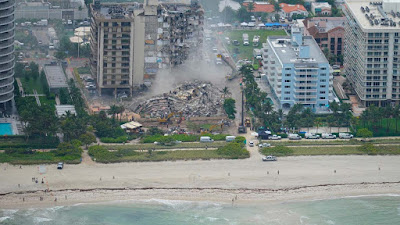South Florida is sinking and threatened by sea level rise. It's never been more clear its buildings are in danger.
Dharna Noor
Today 9:00AM
GIZMONDO/EARTHER
On Thursday, a 12-story beachside condo building just north of Miami Beach collapsed, killing at least four people with almost 160 still missing. It could be a scary sign for the future, particularly as sea level rise undermines the very foundation that South Florida sits on.
Long before the Champlain Towers South condominium in Surfside crashed, the building started sinking. An April 2020 study found that the area showed signs of land subsidence—sinking brought on by natural occurrences like sinkholes and exacerbated by human activities like extracting fossil fuels and groundwater. The study’s authors told USA Today that back in the 1990s, the building was descending at a rate of 0.08 inches (2 millimeters) per year, though it’s not clear that that necessarily contributed to its horrific collapse.
Officials are just beginning their investigation into what caused the building’s devastating crash. It will take more data to suss out what happened and the role, if any, subsidence played.
“At this point, any hypothesis is not more than a simple speculation,” Henry O. Briceño, a professor at Florida International University who studies water quality and geology, wrote in an email. “We should wait for the engineers to collect and analyze the information.”
READ MORE
Ground Temperatures Hit 118 Degrees in the Arctic Circle
UN Says the Great Barrier Reef Is 'In Danger,' Causing Australia to Have a Meltdown
But though the specifics of the crash are still under investigation, it’s been clear for decades that sea level rise and subsidence threaten infrastructure—and people—in South Florida. And the time to address those risks is now, particularly with what the next few decades hold for the region. Sea level rise is expected to accelerate. A report released last year found that Miami “faces the largest risk of any major coastal city in the world” because of the sheer amount of expensive real estate and people living in such a fragile place. An estimated $3.5 trillion of real estate is at risk of inundation by the 2070s, according to the report. Those buildings, though, are ill-equipped for rising seas.
“While it is too early to determine the cause, it is definitely not too early to worry about how building and other infrastructure will be impacted as the flooding from sea-level rise worsens, and whether there is a plan to modify and sustain these buildings or whether they should ultimately be abandond and removed,” Andrea Dutton, a geoscientist at the University of Madison Wisconsin and former associate professor of geology at the University of Florida, wrote in an email.
Buildings in Surfside and Miami Beach are constructed atop reclaimed wetland. Underpinning them is porous limestone, which forms the region’s geological base. As rising seas encroach on the area—whether from storm surge or increasingly common sunny day floods—brackish, corrosive groundwater can get pushed up through the limestone, causing problems for structures.
“If seawater penetrates a column and reaches the rebar, it will oxidize and the products would increase the volume, creating stresses which in turn could crack the concrete,” said Briceño, noting inspectors probing the Surfside collapse “will have to check if something like that happened.”
Whether or not these factors were a factor, though, they could certainly threaten infrastructure in the future.
“Structures will be subjected to conditions for which they were not designed, like being under seawater permanently,” said Briceño. “Concrete mixes are prepared for what they are supposed to withstand according to design, both, mechanically and chemically.”
Tragically, the Champlain tower was due for a 40-year inspection soon, which could have shown it was at risk of falling in. With such dire threats afoot, officials may have to consider holding such inspections more often. Dutton feared it may even be time to start moving people and infrastructure out of Surfside altogether, a fate that some areas are also already considering due to rising seas.
“One of my concerns is that urban hardscape will become flooded without a plan to remove such infrastructure, and then our coastlines will just become a pile of concrete, metal, and glass rubble,” she said.
Dharna Noor
Earther staff writer. Blogs about energy, animals, why we shouldn't trust the private sector to solve the climate crisis, etc. Has an essay in the 2021 book The World We Need.

No comments:
Post a Comment